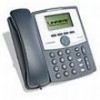Linksys SPA922 Cisco SPA9000 Voice System Using Setup Wizard Installation and - Page 35
Network Setup Review, Infrastructure, Cabling and PSTN/ISDN Lines - power supply
 |
UPC - 745883570836
View all Linksys SPA922 manuals
Add to My Manuals
Save this manual to your list of manuals |
Page 35 highlights
Preparation Network Setup Review 3 Network Setup Review The Local Area Network (LAN) is the communication platform used by the SPA9000 Voice System for allowing communications among the telephone users and between the telephone users and the external VoIP, PSTN or/and ISDN network services. This LAN is composed of the data wiring (UTP cabling), networking equipment (switches and routers/access device) and the telecommunication (PSTN or ISDN) lines. The Local Area Network (LAN) may be already installed or it can be installed and configured at the time of installing the SPA9000 Voice System. Below are the general recommendations to ensure proper operation of the SPA9000 Voice System. Infrastructure, Cabling and PSTN/ISDN Lines • AC outlets: Ensure there is an AC outlet available for every LAN and Cisco SPA component that requires AC power. If you are using a Power over Ethernet switch, SPA9x2 phones do not require an AC outlet as they are powered by the switch. • Ethernet cabling: Ensure there is a Ethernet cabling system and that there is an outlet for each Cisco SPA device. It is recommended that Ethernet cables are UTP CAT 5e or better. • PSTN and ISDN lines: Ensure that the lines are operative and that any features, such as caller identification, operate properly before starting the installation. Ensure that the cables are available in the location where you are installing the Cisco SPA devices. • UPS: If you are using an Uninterrupted Power Supply (UPS) mechanism, ensure that the SPA9000 Voice System design is covered by securing the router and switch AC connections and the Cisco SPA devices and by using the Power over Ethernet adapter (POES5) for the non-POE products (SPA9000, SPA400, SPA9x1 phones). Also ensure that devices such as the WAN modem, CSU/ DSU, or DDS modem are connected to the UPS. SPA9000 Voice System Installation and Configuration Guide for Setup Wizard 33















